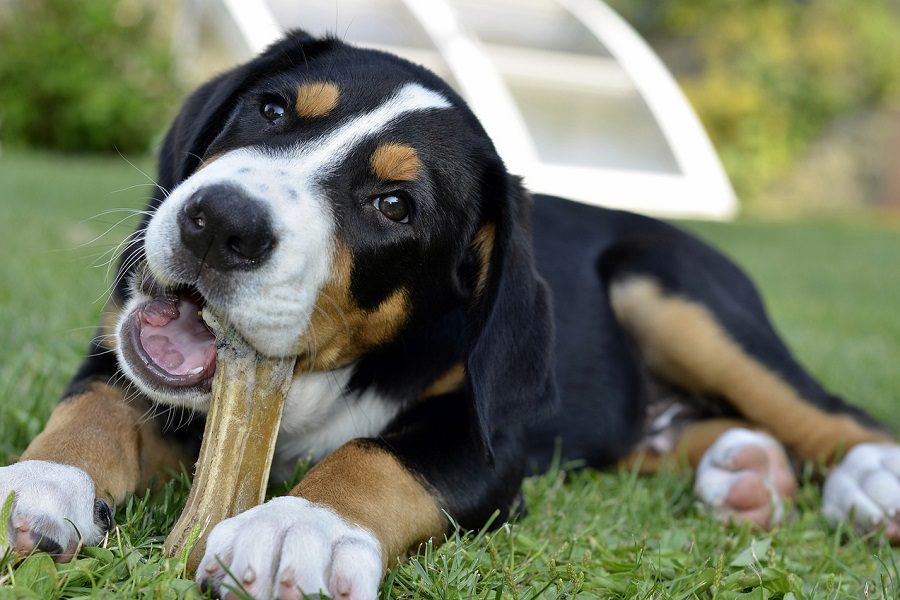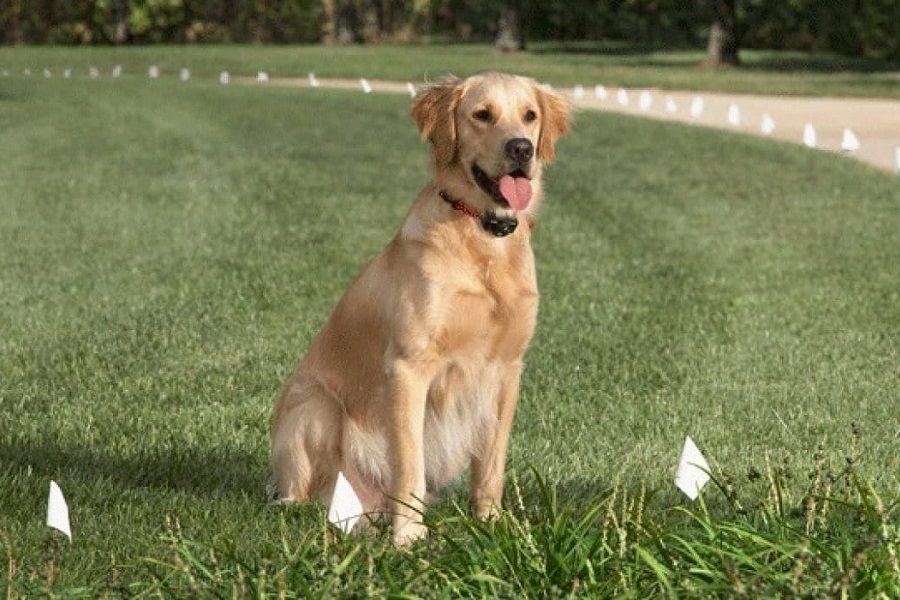Last Updated: 1 year ago
Like most other animals, dogs too are particularly good at cleaning themselves up.
It’s not surprising!
Centuries before humans started domesticating these furry friends, dogs pretty much lived in the wild. Centuries later, they’ve definitely become man’s best friend, but their primal instincts are still present if maybe a little conditioned.
How Dogs Keep Themselves Clean Naturally
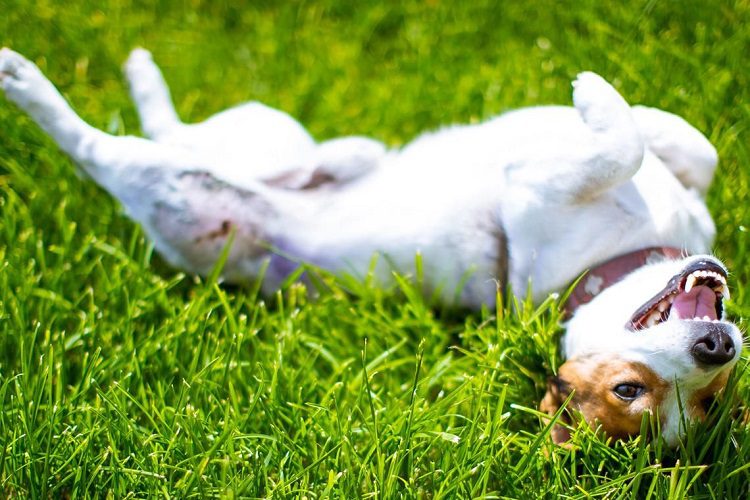
You might have seen your pet show these instincts in ways more than one.
Sniffing around, getting territorial about those they think are a part of their pack, and even in the way, they groom themselves.
Shaking It Off
You may be baffled at why your well-looked-after dog gives its mane a glorious shake several times – while today’s sanitized indoor conditions have reduced how much dirt, dust, and even fleas make their way to your pet’s fur, dogs still shake it out like their ancestors who lived in the wild did.
This not only helps them dust off mud and dirt, it also helps to shake off any dead ticks and fleas that might be hiding in their fur.
It’s a biological thing. Dogs have multiple nerve receptors on their hair (fur?) follicles, and this makes them extremely sensitive to the tiniest sensation or pressure.
This was also necessary for the earlier wild days, both as a caution as well as cleaning since dogs living in nature probably spent a lot more time on the grass and mud than their petted progeny.
Scratching And Nibbling
While this may not exactly be the canine version of Rapunzel, dogs do routinely comb out their own fur. If you’ve seen a dog scratch its own fur or nibble on it, there’s a good chance it’s a part of its daily beauty regimen.
Dogs have oil glands under their fur, and it is precisely these glands that make your canine’s coat all shiny and sleek. While today’s dogs are pampered to no end, in their earlier times, dogs pretty much had to devise their own cleansing, moisturizing, rejuvenating routine.
When your dog nibbles or scratches its fur, it’s a way of stimulating these oil glands to make sure the fur doesn’t dry out.
In addition, your dog’s sharp teeth also help comb out dust particles or dirt from the fur. While a little scratching is alright, it may be a warning sign if you see your dog doing it too frequently or wounding itself.
Rolling Around
You’ve seen this too many times – you take your pet out for a good time at the park and the next thing you see is your dog is rolling about in the grass and mud.
It’s worrisome because you have a lot of cleaning to do back home, but it’s funny that what humans think of as messy business, dogs actually do to clean their skin out.
Think of it as an exfoliating treatment. Just as you’d use a face scrubber to slough off dead skin from your elbows and knees, grass and mud cause friction, helping to dislodge debris and dirt from fur, at times, even get rid of excess fur.
Plus, it also helps to get rid of dead skin and ends up stimulating hair follicles. Have you ever felt really good about your back being scratched?
You’ve probably seen how delighted your furry friend is when you give them a good, long scratch – it is comforting and calming, and years ago, when dogs didn’t know humans would turn them into a family, well, they had to figure out their own comfort.
Licking
Before dogs became used to being treated like royalty, there weren’t too many things they had at their disposal when it came to keeping their bodies clean.
On the other hand, they didn’t need to look much further. If you’ve ever been licked by a dog, you know that feel-good feel of a dog’s tongue on your palm or face.
For a dog, that rough, grainy tongue is like an inbuilt loofah – it helps to brush away dirt and dust. Plus, it also allows dogs to lick their wounds – saliva has always been nature’s answer to antiseptics.
After reading all of this, it is almost natural to think: if dogs are so good at keeping themselves clean, why do they need a special cleaning routine, especially when they aren’t even outdoors anymore?
Fair reasoning, except when dogs are pets, their lifestyle is far too different from how it might have been in the outdoors, and this lifestyle upgrade changes a few things for your pet.
For one, being an indoor pet does funny things to your pet’s canine instincts and responses. You’ll notice that a well-groomed dog will rely more on petting and scratching and belly rubs to feel better, as opposed to fixing its own needs by rolling around.
In addition, while it’s true that staying indoors a lot keeps your dog generally protected from dirt and mud, that doesn’t mean it doesn’t get dirty. Staying around humans means constantly being around dust particles, dead skin, and toxic substances in the air, which definitely leave their mark on your dog’s fur.
In addition, most dog owners tend to live in temperature-controlled homes, which means other than their daily walk, your canine companion has to make do with drier air thanks to modern air-conditioning and unnatural light.
Plus, think of all the substances that dogs aren’t naturally used to, but have to come in contact with – chemically-treated leather, rugs and carpets made from synthetic fiber, and plastics – these aren’t substances that a dog is naturally used to, and it might cause allergies.
The most important bit – when dogs are in the wild, they are free to roam about wherever they want. This also means, that there’s nothing to stop them from taking a dip in the nearest pond or lake or rolling around to their heart’s content in a grassy patch.
No matter how much you’ve worked into making your home dog-friendly, there’s no way your dog is going to find any water source to flap about in, other than your bathroom.
That’s the problem – our modern homes aren’t quite meant to satisfy all of a dog’s natural instincts.
The end result?
A dog that still displays its wilder instincts, is leading the pack or licking itself, but in a watered-down version. With no ponds or lakes or grass around, it’s really necessary to take your dog’s grooming into your own hands.
Dog Shampoo Vs Human Shampoo
While your dog shares the same space as you and is exposed to the same light, temperature, and dust as you are, it doesn’t mean you can pretty much use your own shampoo for your pet. Not even a mild, baby shampoo, no.
It was one thing for dog owners to use regular soap in the old days, but today, there are just as many options when it comes to pet grooming products as there are for their human parents. Yep, from hair fall control to dandruff relief to oily hair – pet stylists and groomers will often prescribe intense grooming rituals for pets too.
Dog shampoos are different from human shampoos in a number of ways, but here are the most common points of difference.
Ingredients
Depending on what it is targeting, a dog shampoo could have several ingredients that rejuvenate, cleanse, soothe or purify your dog’s skin.
pH Balance
The pH composition of your dog’s skin is very different from yours. Human skin has a pH of around 5.5 to 5.6, but dog skin has a higher pH of between 6.2 and 7.4, making it way more neutral.
This means that even the mildest shampoo you might use on your skin could be really acidic for your dog’s skin, resulting in a pH imbalance.
Chemical Composition
Dog shampoos will generally use chemical components that are much more gentle on your dog’s skin. While human skin is made up of anywhere between 10-15 layers, dog skin only has about 3 to 5 cell layers, making it really sensitive.
Common detergent-based cleansing agents will prove to be too harsh for your dog’s skin, drying it out and causing a number of other problems.
On the other hand, dog shampoos are also sometimes medicated, particularly anti-bacterial and anti-fungal shampoos, or those meant for dogs who have ticks or fleas in their fur.
Human Shampoo On Dogs: A Complete No-No
There’s nothing worse you could do to your pet than subject the poor thing to harsh, detergent-laden shampoos meant for tougher human skin.
Instead of helping your pet stay clean, you might actually end up causing a lot more scratching and nibbling since human shampoo will usually dry out your dog’s skin.
This not only leaves your dog much more prone to infections but also causes dry, itchy skin and even wounds that don’t heal quickly. Exposing your dog’s skin to harsh shampoos is also going to cause havoc with its pH balance.
This means that the natural oils present in your dog’s fur will get stripped away too, making your dog’s skin an open playground for all kinds of germs, bacteria, parasites and viruses.
In addition, when your dog’s fur loses these natural oils, it leaves behind a dull, unkempt-looking fur.
So many dog owners will begin to bathe their dogs more frequently if they notice a foul odor in their dog’s fur, not realizing that they are actually making the problem a million times worse.
If your dog has dry, itchy skin thanks to the wrong (human) shampoo, it is going to scratch itself a lot more often, and is going to be restless and anxious. Even worse, it may begin to associate bathing with an unpleasant experience, causing it to behave more aggressively or disobey you when it is time for a bath.
Common Dog Skin Problems
While the wrong shampoo can worsen your dog’s skin, the right shampoo can actually help in resolving the most common dog skin problems that pet parents have to deal with.
Allergies
Pets who live indoors are exposed to so many more synthetic materials. Think about all the things your dog touches – your couch, your rugs and carpets, cement walls, plastic toys, and surfaces.
All these could be potential allergens, which means the more these substances come into contact with your dog’s skin, the higher the possibility of an allergic reaction.
Itchiness
Your dog might have an itchy coat for a number of reasons. It could have to do with moisture trapped under the fur, dry, flaky skin, residue from grooming products, or even a change in weather.
More often than not, itchy skin is a result of pH imbalance on your dog’s skin, and certain shampoos can really help neutralize the acidity levels, while also giving your pet’s skin just the right amount of moisture.
Dandruff
If your dog’s skin is too dry or too oily, it will often cause dandruff, causing flakes of dead skin to accumulate under the fur or fall off.
The right dog shampoo helps to restore the moisture balance by controlling how much oils the glands secrete – in the case of dry skin, stimulating the follicles to produce more oils.
Sensitive Skin
If your dog’s skin is particularly sensitive and prone to rashes, a soothing shampoo will actually help cool and heal the itchy skin, as well as protect it from drying out too much.
Fleas Or Ticks
These are probably a pet owner’s worst nightmare. Dogs are extremely sensitive to flea bites, and will sometimes scratch a flea bite till it turns into a wound.
Medicated dog shampoos are super effective when it comes to killing fleas as well as helping to get them out of your dog’s fur by loosening their grip.
Shedding
If your dog seems to be shedding a lot more fur than normal, it could be a reaction to a wrong grooming product. Shampoos that are too harsh will strip the hair follicle of its nutrients, causing hair to become weak.
There are several kinds of shampoos specially formulated to control excess shedding, in addition also nourishing the hair to restore shine and strength.
Choosing The Right Dog Shampoo
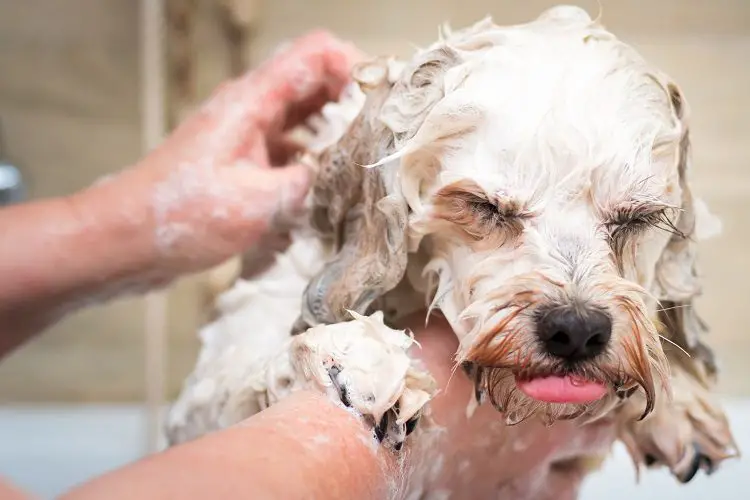
Different dogs have different bathing needs, depending on their breed, size, and type of fur.
You might want to think about the following things before you go ahead and pick the right shampoo for your dog.
What Kind Of Coat Does My Dog Have?
Different breeds of dogs have different coats, and this determines the kind of cleaning your dog’s fur needs.
For example, if your dog has really oily fur, it may need a shampoo that deep cleanses its skin to remove all kinds of build-up from the oil glands, but is still gentle enough on the fur to not make it rough.
How Long Is My Dog’s Coat?
The second factor to consider while picking a shampoo for your dog is how long its coat is.
Long-haired or curly-haired dogs, for example, will need a shampoo that detangles and smoothens, so that when dry, your dog’s coat looks sleek and glossy, and not matted.
Dogs with shorter fur may need a gentler formula since the skin is a lot more exposed to air and might dry out with harsh formulas.
How Big Is My Dog?
While this isn’t really a factor in determining the kind of shampoo your dog will need, your dog’s size does affect how often you bathe your dog – typically, bigger dogs need to be bathed more often, but here too, there are few things to understand.
How Often Should You Bathe Your Dog?
There seems to be an endless debate on how often one should bathe their dog. Should all dogs be bathed frequently? Are there some dogs that need to bathe more frequently than others?
Ideally, most dogs should be bathed once a month, but this really depends on your dog’s breed and the kind of fur it has. For example, breeds like Basset Hounds have really oily fur, and may actually need bathing once a week, particularly if you live in humid, hot weather.
On the other hand, Golden Retrievers actually have coats that repel water, and if bathed too frequently, they may lose the natural oils in their coat, making it look dull and unkempt.
It isn’t just about bathing – brushing your dog’s coat is also just as important. In fact, some breeds with thicker coats can actually benefit from fewer baths but a lot of brushing in between baths, which helps to redistribute the oils in their coat without adding unnecessary moisture.
How often you bathe your dog also depends on the reason for bathing him or her. If it’s just part of maintaining hygiene, stick to the frequency mentioned above.
However, if you have a dog with a skin condition, or with ticks and fleas, then not only will the frequency of your doggy bath change, you will also have to use specific kinds of products to bathe your pet.
Dog shampoos designed for specific uses have specific ingredients, and while there are quite a few different ones, here are the most common kinds of dog shampoo:
Soap-free, pH-neutral shampoos containing substances such as oatmeal or aloe vera. These are great for normal or itchy skin, helping cleanse the skin as well as soothe and reduce inflammation.
If your dog has long fur and is prone to dandruff, you might want to consider using a shampoo containing selenium sulfide, which keeps the fur hydrated but prevents the formation of dandruff by letting more than necessary oils and grease accumulate.
If your pet is recovering from a wound or an infection, use a gentle but antibacterial shampoo that has antiseptic properties. Look for shampoos containing chlorhexidine, which can help to treat bacterial skin infections and also keep healing wounds away from the risk of infection.
For dogs suffering from fungal skin infections, it’s best to use shampoos specifically containing antifungal agents such as miconazole or ketoconazole which prevent moisture from retaining and becoming a breeding ground for infection-causing fungi.
How To Bathe Your Dog
Different breeds need different bathing routines, but there are a few basics that remain the same, irrespective of the kind of dog you have.
Brushing
Remember to brush out your dog’s fur – doing this helps to detangle knots, get rid of dirt particles and makes it easy to rinse out the shampoo easily.
Cleansing
Wet your dog’s fur with plenty of water – this is important since shampoo can stick to dry fur and cause allergies or irritation. Work up the shampoo into a rich lather, and rub it into your dog’s skin gently.
Rinsing
Rinse off the shampoo with lots of water, using a second rinse for dogs with thicker or longer coats.
Drying
Let your dog use their instinct and have a good shake – this will help eliminate unnecessary moisture from the fur and quicken the drying process.
Tips For Bathing Your Dog
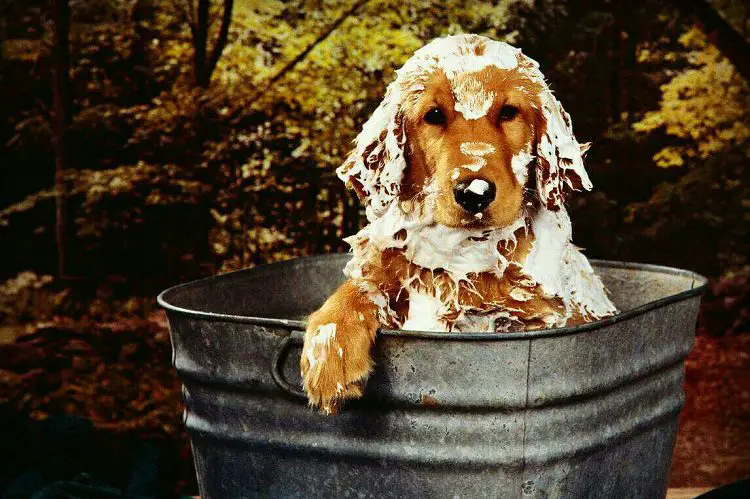
- Brush your dog’s fur before you proceed to give him or her a bath, even more so if it is matted. Matted, dry fur is a hiding place for too many things that aren’t too good for your dog’s skin. It tends to make dirt and dust cling more, as well as traps moisture
- Keep the shampoo away from your pet’s eyes and ears
- You may love a cold shower on a hot summer day, but your dog’s skin is very different from yours. Use lukewarm water, even in summer, but also make sure the water is never hot
- Always use lots of water to rinse off shampoo and other products, otherwise, this may lead to a layer of buildup on your dog’s skin, causing irritation and itchy skin
- Remember never to use a blow dryer on your dog, and certainly not a hot dryer. Factor in the time it takes for your dog’s coat to dry, and schedule his or her bath accordingly – dogs with thicker, longer coats, especially, should be air-dried after a bath, since any moisture left behind could cause fungal infections
- Air from a blow-dryer is too hot for dogs- it could leave their skin itchy and dry, or even scalded from the high temperature
- Calm your dog down while bathing him or her – talk in a soothing, playful voice and have an easy, gentle grip
Bathing: Too Much, Too Little
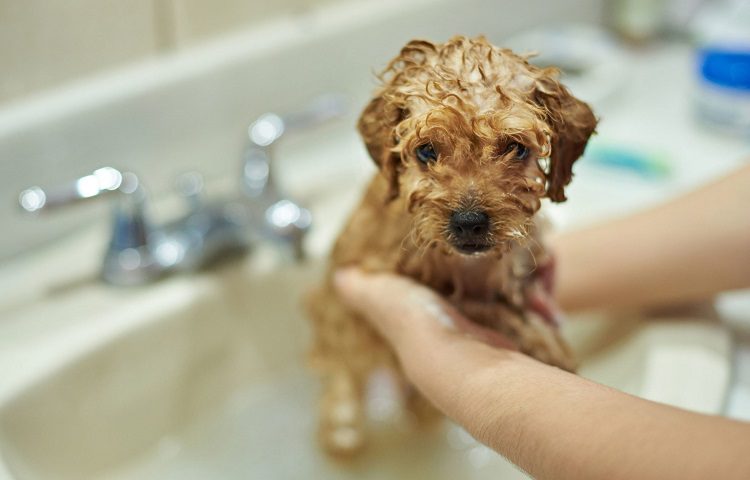
This is probably the one area where similar rules apply to you and your dog – both, bathing too frequently and not bathing frequently are problematic.
If you give your dog a bath too frequently, you’re exposing its already sensitive skin to more chemicals, increasing the potential for allergy.
Too many baths too frequently also mean that the pH balance of your dog’s skin is imbalanced even before it has a chance to correct itself, causing dry, itchy skin and excessive scratching.
On the other hand, not bathing your dog frequently enough will cause a buildup of oil and dead cells on the skin, leading to dandruff. This will also cause bacterial and fungal growth, causing infections and making your dog restless and even sick.
Plus your dog’s coat will look unkempt and dirty, and you most certainly don’t want to be hugged by a stinky, foul-smelling dog at the end of each day.
DIY Oatmeal Shampoo
If you feel like you simply can’t trust chemicals with your dog’s skin, here’s a simple, easy-to-make DIY oatmeal shampoo for some pet pampering.
- Mix up a cup of ground oatmeal with ⅓ cup of baking soda in a food processor
- Add a few spoonfuls of coconut oil, or open a couple of vitamin E tablets into the mix
- Pour in enough water to form a paste – if your pet isn’t allergic to herbs, you could infuse this water with a few sprigs of rosemary or lavender, since these smell really good and also have soothing properties
Use this shampoo just like you would use any other shampoo, but remember to rinse out all the oatmeal from your dog’s fur.
Conclusion
Whether you opt for a DIY shampoo like this or a branded one, it’s important to know how exactly to go about choosing the right shampoo for your furry friend, so you give them the best TLC that they deserve, for being your best friend.
Resources:


